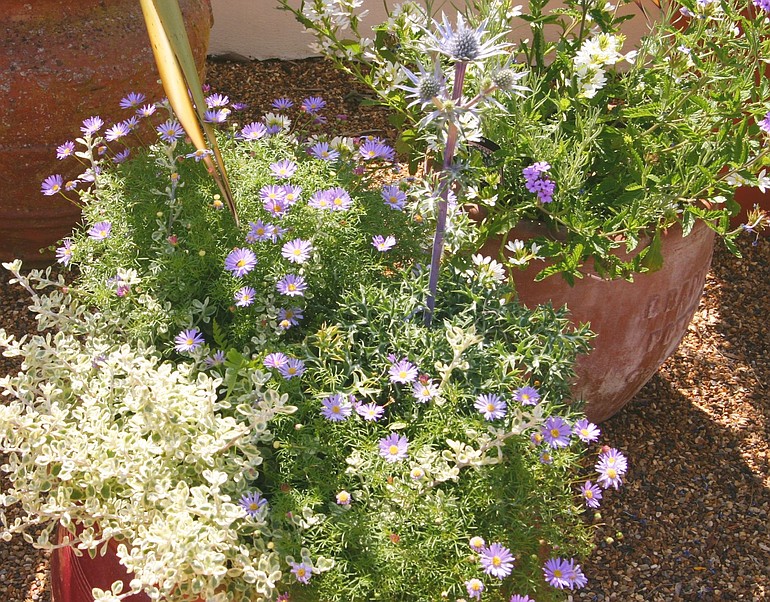Late summer is one of the shortest seasons in the garden. It is marked by subtle transitions as the many colored day lilies begin to wane and black-eyed Susans (Rudbeckia hirta) come into full glory.
The days are clear and rainless; sunburn hot. My favorite planting — of red and white striped petunias, gray leaved, trailing licorice plant (Helichrysum petiolare) and richly scented purple heliotrope — needs daily water during a hot spell.
Hanging baskets that are filled to overflowing with annual geraniums, wave petunias and trailing nasturtiums would wither away if overlooked and left to go a full day without water in these conditions. If you do not have a drip system and cannot water every day in hot weather, be sure to water until the pot, planter or basket is thoroughly soaked and water runs out the bottom. This is one time of year when the cool evening hours come as great relief to the gardener.
No gardener can peruse his or her own garden without pulling a stray weed or clipping off a dead branch here and there. I begin almost every day with a garden walk. Since I usually carry a roll of green, stretchy garden tape in my pocket, it was convenient this morning to stop at the first arbor along the path. I used the tape to tie up the side branches of the climbing rose, “Zepherine Drouhin.” The branches were beginning to flop from the weight of the roses, pulling away from the supporting trellis.
This rose is a perfect climber for walkways since it is virtually thornless and its scent is strong enough to fill the air for several feet. Its rich, fuchsia pink color contrasts with the summer blooming golden clematis (C. tangutica) growing up the other side of the arbor. In less than an hour, both plants were properly tied in place. As a result, the eye is drawn up to the top of the trellis where the plants meet in a cascade of contrasting color.
Years ago, while visiting the beautifully detailed gardens of Linda and Al Bailey in Battle Ground, I saw the delicate, eastern redbud tree, Cercis canadensis, or forest pansy, grown to perfection. Its rounded, burgundy leaves catch light and reflect color all through the summer months. I decided to add one to my own garden at the first opportunity. Four years later, it is still one of my favorite garden plants.
The flowering crab-apple, “Malus Dolgo,” signals the closing days of summer with a heavy crop of tart, sweet-sour apples that hang in clusters as red as cherries. I marvel every year when I remember that this tree, now 25 feet tall and wide, once fit in the trunk of my car along with two bags of composted manure.
Another plant that signals the decline of late summer and the inevitable arrival of autumn is the snowberry bush (Symphoricarpos spp.). This Northwest native is a midsized, upright shrub. Multiple plants will grow together and form a thicket. It is especially good for erosion control on a sloping hillside. Red, pink or white marblelike fruits follow the pink tinted flowers from late summer into winter. New hybrids have recently joined the family of this solid, reliable shrub for the Northwest garden.
Many of the repeat blooming roses are at their peak. The climbing rose “New Dawn” is in a second flush of silver-pink blooms. This rose looks especially lovely when rising up through a garden structure. The large shrub rose commonly referred to as the “Butterfly Rose” (Rosa mutabalis) is covered with blossoms in a mix of hot and cool colors. As new flowers open, the old ones fade from bright cerise pink to rosy pastel and to all the colors in-between.
Occasionally I think to myself, “This is it. The garden is filled and thriving with plants. I have enough.”
At the first sight of a new plant, my resolve flutters away with the breeze. Once again, my mind races with ideas for filling the bare spots where the lupine and poppies have died away. I enjoy certain perennials that reseed themselves and return each year in surprising new locations. The simple daisy is a prolific reseeder that I continue to encourage in my garden, year after year.
Robb Rosser is a WSU-certified Master Gardener. Reach him at Write2Robb@aol.com.



